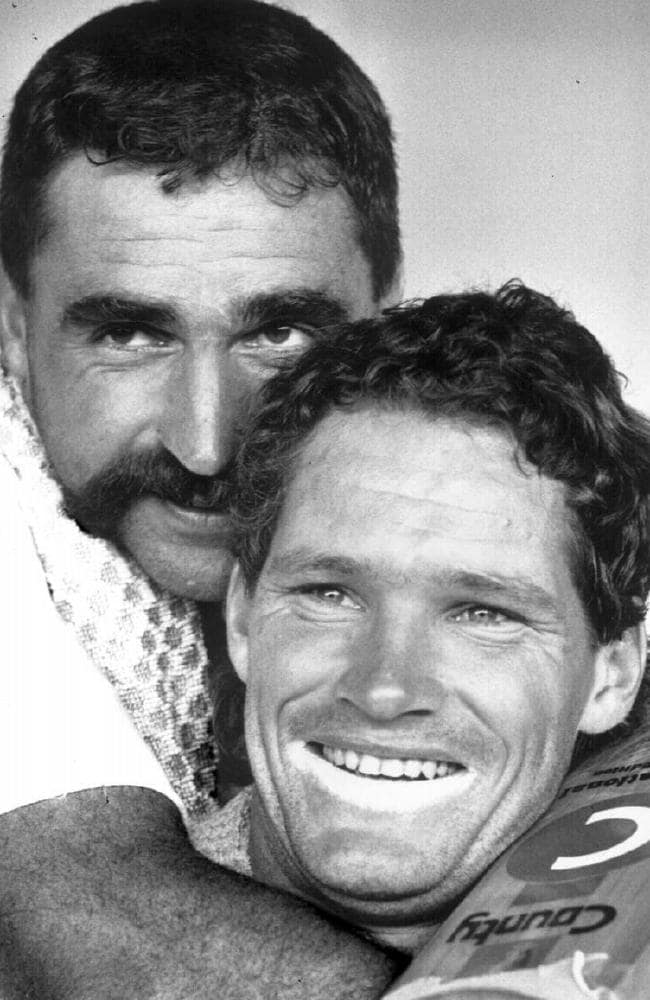Advantage Education’s Darryl Fry was the guest speaker at the Western District Football Umpires Association 2019 Presentation Awards Dinner.
This post is adapted from the presentation he gave.
One of the most memorable and intimidating experiences of my cricketing career was when I felt the wrath of former Australian Test fast bowler, Merv Hughes.
If you don’t know who Merv Hughes is, he became a cultural icon during the 1980s and 90s, capturing the public’s hearts and minds with his aggressive pace bowling, extroverted personality, big frame and bristling moustache.
Merv played 53 Test Matches and 33 One day Internationals for Australia during the 80s and 90s and is still a prominent figure in the media today.

You may have seen him on reality TV shows like Celebrity Overhaul or I’m A Celebrity, Get Me Out of Here.
Or maybe you have seen him on ads for Sportsbet, or leading tour groups to the Ashes matches in England.
Merv and I crossed paths when he came out of retirement for the 2000/01 cricket season to captain Footscray’s Second XI in the Victorian Premier Cricket competition.
I was captain of North Melbourne’s Second XI at the time and we played Footscray on its home ground, which is located just near the Footscray Park campus of Victoria University.
The name of that ground?
The Mervyn G. Hughes Oval.
You can imagine that it was a slightly surreal feeling going out to toss the coin at the start of the game against Merv on the oval that bears his name.
I lost the toss and Merv decided that his team would bat first, but we bowled well and dismissed Footscray cheaply.
Merv came in to bat at number eight and smacked a few balls to the boundary, but he, like his teammates, didn’t occupy the crease for very long.
When our turn came to bat, we were able to pass Footscray’s total fairly quickly and comfortably thanks in part to Merv being injured and unable to bowl.
As we built a healthy lead, I started contemplating a declaration so that we could send Footscray in for a second innings and press for an outright victory.
Being in a position to declare an innings closed is a pretty rare experience for a cricket captain and one that I had never had before.
I wasn’t sure of the timing and etiquette required, I decided to wait until the next break in play, which was the drinks break, before declaring.
When Footscray’s volunteers took the drinks onto the field and I called my batsmen back into the clubrooms, signifying our declaration, Merv was not impressed.
He provided me with his unique brand of what I will describe as, frank and honest feedback.
I was surprised and intimidated by Merv’s outburst, but was able to absorb the main theme of his displeasure, which was that I had wasted the time of Footscray’s volunteers who had prepared the drinks.
I have since learned that there is a protocol in cricket that before you declare at a drinks break, you tell the volunteers who prepare the drinks not to bother preparing the drinks because the players are coming off the field and will get their own drinks.
Merv’s mood didn’t improve as we pressed home our advantage on the field, bowling Footscray out again and then chasing down the runs we needed in the second innings to win the game outright.
It was great to get an outright win, because they, like declarations, are a rare occurrence in most forms of cricket.
However, my satisfaction with the outright win was tempered by the fact that I had to sit down with Merv at the end of the game to complete the traditional captain’s report on the umpires.
As soon as Merv sat his burly six foot four frame down opposite me, he eyeballed me and asked me why I had declared at the drinks break.
When I explained that I was a relatively inexperienced captain and it was the first time I had been in a position to declare, Merv’s annoyance with me reduced and we were able to complete the captain’s report without any incident or Merv feeling the need to provide me with additional frank and honest feedback.
That same season I played against another high profile former Australian cricketer who like Merv, had come out of retirement to help his Premier Cricket Team’s Second XI.

Dean Jones was a swashbuckling batsman who played 52 Test matches for Australia between 1984 and 1992 and was named in Australia’s Greatest Ever One Day Team when it was announced by ESPN in 2007.
Deano, as he was known, demonstrated his class as a batsman when we played against him while he was representing his Premier side, Melbourne Cricket Club.
He took our attack apart and made a hundred against us in very quick time.
Dean found the going against our bowlers so easy that at one stage he asked one of the umpires if he had any golf tees in his pocket.
That was Dean’s none too subtle way of signifying to all concerned that he was ready to tee off on anything our bowlers sent down.
If any other batsman had said this, we would have probably told him to pull his head in, but the fact it was Dean Jones and he was in full flight, gave us no grounds for a comeback.
Being on the same field and watching Dean bat was an amazing experience.

Another great batsman I had the privilege to play against and watch first hand was Warren Ayres.
Ayres never played for Australia, but he represented Victoria in 46 first class matches between 1987/88 and 1996/97, scoring 2611 runs at an average of 33.91, with seven centuries and 11 half-centuries.
Ayres is also a legend of Victorian Premier Cricket. He is the all-time leading run-scorer in First XI matches with 15277 runs at an average of 42.43. His 41 First XI centuries are also a Premier Cricket record.
Ayres’ top score of 218 was made for Melbourne’s First XI against North Melbourne’s First XI at the Albert Ground in the 2001/02 season.
I was part of North Melbourne’s First XI team for that game, one of 17 First XI matches I played during my four seasons of Premier Cricket.
I helped contribute 120 runs to that game. Unfortunately they were all made by Ayres.
Ayres was on 98 when he went to swing a delivery from one of our spin bowers through the leg side near where I was fielding at mid-wicket.
I saw the ball off the bat and moved low to my left to take the catch.
The ball went into my outstretched left hand. And then it went out.
In cricket terms, it was a very costly dropped catch and one that infamously connects me to Ayres’ Premier Cricket dominance.

My journey towards Premier Cricket was aided in no small part by my involvement with St Andrew’s Cricket Club in the Hamilton District competition during my teenage years growing up here.
I was mainly a top order batsman and played in St Andrew’s under-14 and under-16 teams before making my A grade debut for the club at the age of 17.
I was fortunate enough to be part of St Andrew’s A grade premiership team in 1991/92, under the captaincy of the late Dale Templeton.
We lost the A grade grand final the following year in a close game against a City XI side that was well lead by Phil Forsyth.
That grand final proved to be my last game of cricket for four seasons, as study, work as a sports journalist with the Hamilton Spectator, playing football for Hamilton Imperials and expanding my social life became my focus.
It wasn’t until I moved to Shepparton in 1996 to complete the journalism cadetship I started at the Hamilton Spectator that I resumed playing cricket.
After two years of living, working and playing cricket in Shepparton, I changed the course of my career and my life when I moved to Melbourne at the start of 1998 to undertake a Bachelor of Education degree at Victoria University.
This change gave me the time, proximity and opportunity to join North Melbourne Cricket Club at the start of the 1998/99 season and to test my abilities during the next four years.
I joined North Melbourne because two other former St Andrew’s cricketers of my vintage, Simon Tuckett and Sean Fitzpatrick, were at the club.
I played the majority of my first season with North Melbourne in the club’s Third XI and made a few decent scores. I played the following three seasons mainly in the club’s Second XI, with enough First XI games sprinkled here and there to total 17, as I mentioned earlier.
As you may have guessed I didn’t set the world on fire in the First XI.
I averaged a bit over 10 with the bat and my top score was 39.
Some of the best bowlers I faced during my First XI matches include Simon Cook, who played one Test Match for Australia, Shane Harwood, who played T20 and One Day International cricket for Australia, and Allan Wise, who was a State player with Victoria and South Australia.
During my time at North Melbourne, I felt most at home opening the batting for the club’s Second XI, often with my former St Andrew’s clubmate, Simon Tuckett.

My Second XI record is a bit more noteworthy than my First XI record and includes two centuries. 102 not out against Melbourne University and 118 not out against Prahran.
After my four seasons with North Melbourne, I played a season with Yarraville Club in the Victorian Turf Cricket Association and to the surprise of many who knew me, showed all round ability.
I took 27 wickets at an average of 12.81 bowling medium pace and also made 261 runs at an average of 21.75.
Regrettably, part of my decision to go to Yarraville Club was because I wanted to get paid to play cricket.
In hindsight, this detracted from the purity of my involvement with cricket and made the game not as much fun for me.
My attention had also shifted at this point in my life to re-establishing myself in the workforce, this time as a school teacher in Melbourne, and developing a relationship that would eventually lead me to getting married and becoming a father.
Feeling I had gotten everything I could out of the game of cricket and with my priorities changing, I stopped playing.
That was 17 seasons ago.
Plenty has happened between then and now, some of which is relevant to why I returned to Hamilton earlier this year.
The catalysts for my return included the end of my marriage, dissatisfaction with life in Melbourne and the school system in which I worked and also some personal health challenges.
Even though the circumstances leading up to my return weren’t the most uplifting, they have helped to fuel my desire to reconnect to the community of Hamilton and to give back to it as best I can.
It is for this reason, I volunteered to be St Andrew’s Cricket Club’s Director of Coaching and Leadership.
In this role, I am supporting the captains and coaches of the club’s men’s, women’s and junior teams to provide opportunities for anyone who enjoys cricket to have fun, get the best out of themselves and be part of a team environment.
I see myself as a link in the chain connecting the club’s present with its past and future.
In my own way, I am honouring the legacy left by Dale Templeton and the other leaders who were at St Andrew’s Cricket Club when I was a teenager.

